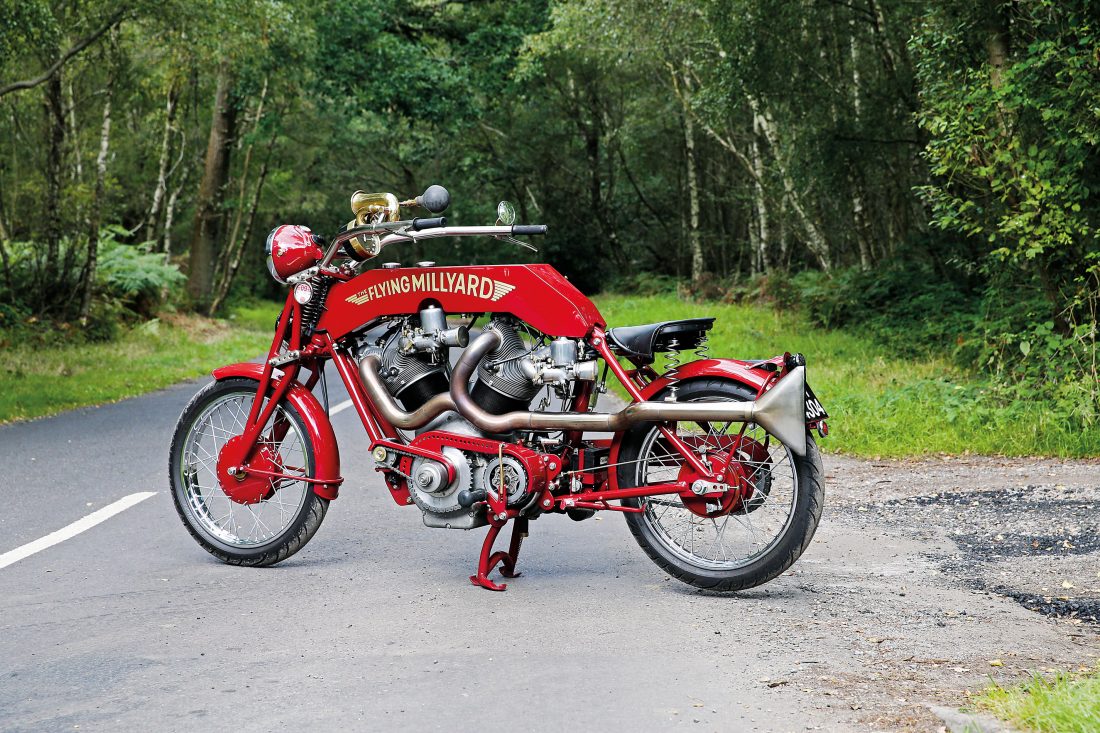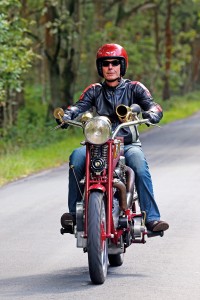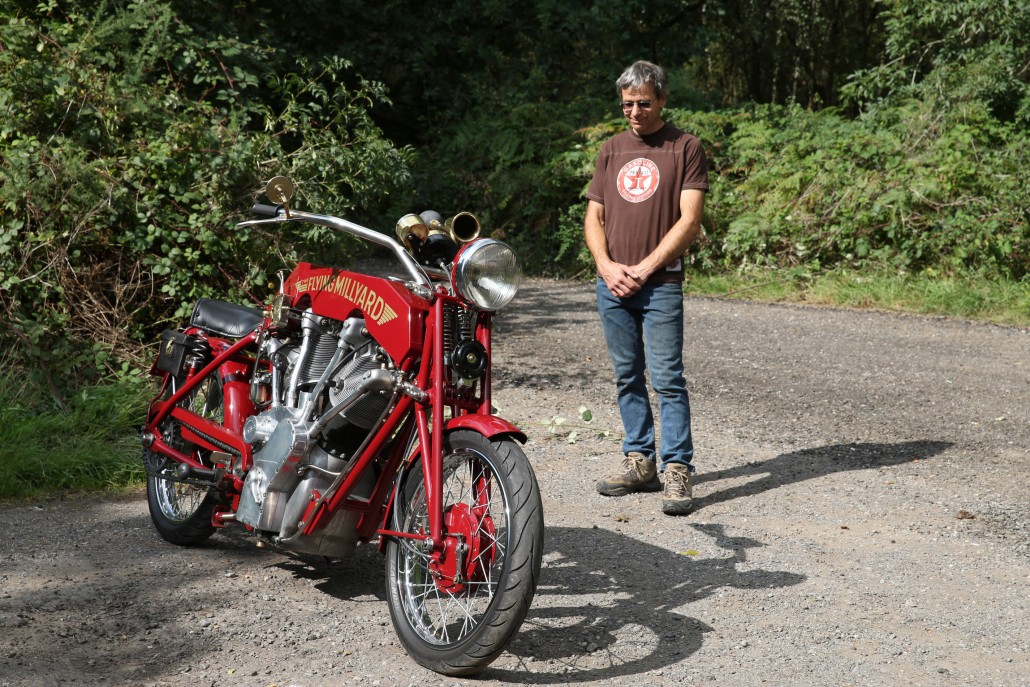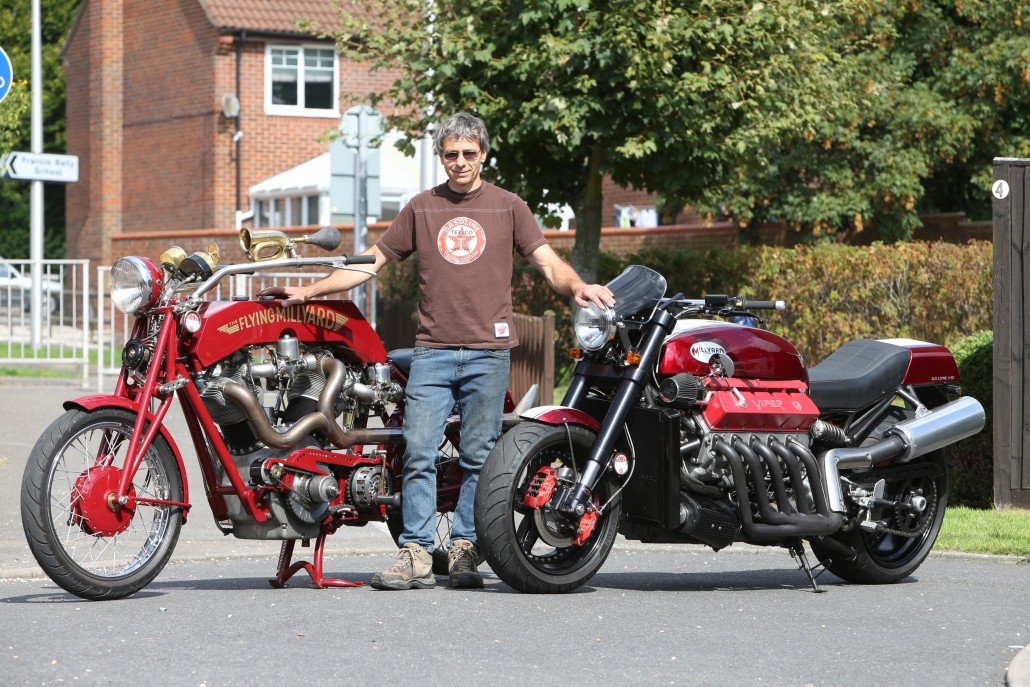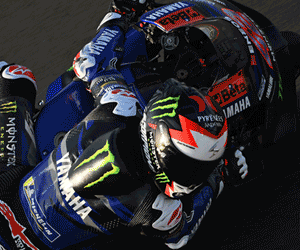Weird and Wonderful Millyard
Creative Alchemy
Some folk like to customise their bikes, others, like Allen Millyard, just take that to a whole new level. His most recent project though, stepped it up a notch even for this engineering genius – after a spur of the moment comment…
Words Roland Brown / Photos Phil Masters
The Flying Millyard is far from the most powerful or high-tech special I’ve ever ridden, but it’s certainly one of the most involving and challenging to ride. As the air-cooled V-twin chuffs gently along a quiet country road, it feels like a vintage bike – except that it’s powered by a gigantic five-litre engine, and is far bigger and heavier than a typical machine from a century ago.
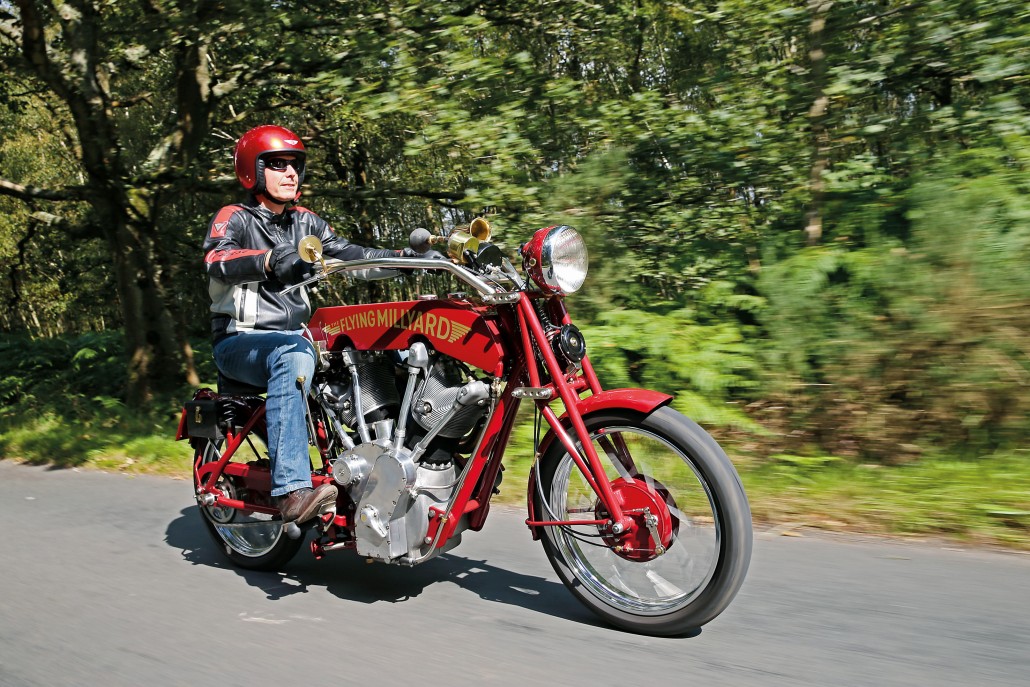 My arms are reaching out to grip tiller style bars that run backwards above the long, maroon-painted tank. Sticking up to the right of that is a long metal lever for the four-speed, hand-change gearbox, plus extra controls for fuel mixture and ignition. I’m sitting over the rear wheel, bouncing gently on the bicycle style sprung saddle and enjoying the long-legged beat of an engine that is turning over at little more than 500rpm.
My arms are reaching out to grip tiller style bars that run backwards above the long, maroon-painted tank. Sticking up to the right of that is a long metal lever for the four-speed, hand-change gearbox, plus extra controls for fuel mixture and ignition. I’m sitting over the rear wheel, bouncing gently on the bicycle style sprung saddle and enjoying the long-legged beat of an engine that is turning over at little more than 500rpm.
The Flying Millyard – named after the Flying Merkels that were among America’s finest V-twins before production ended in 1915 – looks ancient, but that is misleading. It’s the latest in a long line of home-made creations from Allen Millyard, the brilliant engineer who has become well known through the series of spectacular multi-cylinder bikes that he has built over the last two decades.
The huge, close-finned air-cooled cylinders of its V-twin engine are genuinely old, though: they were originally built in the 1930s, for an aeroplane not a motorbike. They formed part of a nine-cylinder Pratt & Witney Wasp radial engine, as used to power planes including the Lockheed Electra in which aviation pioneer Amelia Earhart made her final, doomed flight in 1937.
As some kids do…
Building a bike with just two cylinders is unusual for multi-cylinder expert Millyard, although in some ways it’s a bit like going back to his roots. After starting out as a 13-year-old schoolboy by bolting an 850cc, four-cylinder Mini car engine into a BSA Bantam frame that he’d cut and rewelded to suit, Millyard moved on to built a couple of Honda-engined V-twins, by doubling up the cylinders from C50 and C90 step-throughs.
Millyard’s bike-building career took off when he turned to Kawasaki two-stroke triples, initially with a 415cc, five-cylinder bike based on the KH250. That was followed by a string of four- and five-cylinder machines of up to 1250cc, derived from 500 and 750cc triples. Then he moved on to Kawasaki’s classic four-strokes, firstly with a V8 based on the Z1000 four, then a 2300cc V12 featuring two blocks from the Z1300 six.
Several of those bikes are now on display at the Barber Museum in Alabama. Meanwhile Millyard had moved on to his most outrageous project: the Viper, powered by Dodge’s eight-litre V10 engine, which makes over 500bhp and has been timed at over 330km/h. That and numerous others have won awards at various shows, and it was the Honda SS100 V-twin’s victory at the prestigious Salon Privé exhibition in London that led to the Flying Millyard project.
“I’d won a prize at the Privé with the tiny SS100, and when they asked me what I was going to do next year, all I could think to say was: ‘I’ll build the world’s biggest V-twin,’ ” recalls Millyard, who began looking for a suitable engine shortly afterwards. “Luckily I’d recently taken early retirement, because it took 11 months of almost full-time work to do it.”
Right then, one massive V-twin coming right up
He considered making a complete engine himself before seeing the pair of Wasp cylinders on eBay, and managing to acquire them – against no other bids – for just over £100. The seller turned out to be the Vintage Motorcycle Club, who had been bequeathed them by a former member. “The guy who’d died had bought them as war surplus in 1965 and planned to make a Morgan type V-twin car engine. I thought it was so cool that I was going to make it happen – in a way my project was started half a century ago.”
Millyard created the 4888cc engine by bolting the Wasp cylinders to crankcases that he designed himself, complete with wooden moulds, and had cast by the company that makes the BAFTA (British Academy of Film and Television Arts) awards. “I’m not sure of the cylinder angle: about 60 degrees,” he says, before finding a protractor, lining it up on the engine and then correcting himself: “No, about 70 degrees. That doesn’t matter; it’s just what looked right. As I pulled the cylinders down, the bike was getting longer; if I’d had them any narrower I’d have had problems fitting the carbs.”
Resolving such issues comes naturally to Millyard, who made a camshaft by combining some Harley-Davidson gears with a Kawasaki Z1300 cam that he happened to have. He also fashioned the siamesed exhaust with its fishtail silencer, aiming to create a bike with a vintage look and feel, to contrast with the brutish Viper.
For aero use the nine-cylinder radial Wasp engine would often be supercharged and producing 600bhp, suggesting well over 100bhp would be possible with two pots, but Millyard was not interested in chasing power. “I built this bike not with performance in mind but to sound wacky and to be ridden sedately, sitting right back and occasionally beeping the horn,” he says. “It has a very low power-to-capacity ratio – I reckon it’s making about 80bhp.”
Like almost every component of the bike, the carbs – Amal SU items from a 1960s Mk10 Jaguar car – are either heavily modified old parts or fabricated by Millyard. A wide variety of vehicles provided components: the gearbox combines parts from old MG and Morris 10 cars; the clutch is from a Honda Pan European; the two oil pumps from Fireblades, the generator from a mobility scooter.
Similarly the chassis is based on a tubular steel frame that is essentially hand made in Millyard’s small suburban garage/workshop in Berkshire, west of London, along with the girder front suspension system. He also fabricated the long tank, which holds 23 litres of fuel plus five litres of oil, and needed to be large because the giant motor gulps fuel at around 18l/100km.
Other chassis parts are from classic bikes. A Triumph Trident 750 from the Seventies provided the mudguards and Girling shocks (for the front end; the rear is hard-tail); the drum brakes are from Kawasakis of similar vintage. The 21-inch wheels are from Harley-Davidsons; the speedo an original Smiths clock from the Fifties, modified with Kawasaki internals; the headlamp a BSA Gold Star item donated by a neighbour who’d found it in his loft. The “King of the Road” horn with its rubber bulb is a Twenties original.
Don’t just stare at it
Bringing this gentle giant of a bike to life involves a ritual that must be obeyed. With the bike on its centre-stand I turn on the petrol and oil, the retard the ignition and set the fuel mixture with the levers in the little brass box – hand-made by Millyard, naturally – next to the fuel tank. Then fit the detachable kick-start (a converted spanner, which fits into a box behind the engine when not in use) to a bolt on the end of the crank, turn over the engine slowly a couple of times to prime the cylinders, aided by the low, 6:1 compression ratio… and leap!
The engine fires first time, with a puff of smoke and a slow, surprisingly soft beat from the exhaust, sucking from the giant carbs, and rustling from mechanical parts including the exposed clutch. I push the ignition advance lever half-way, pull in the light clutch lever, select second gear – no need for first – with a slight graunching noise, then let out the clutch. The bike pulls away with another slight graunch, not dramatically quickly but respectably briskly.
It’s impossible to stop smiling as the big V-twin trundles along, the smell of its Castrol R oil adding a hint of traction engine atmosphere. I’m glad that the throttle and clutch, at least, are conventional in operation. But I still need plenty of concentration as I try to remember Allen’s instructions about how and when to advance the ignition and lean the mixture.
Thankfully the bike doesn’t slow when I take my hand off the throttle to change gear. I get it into third and the bike is happy to pull that almost from idle. Soon I’m into top, cruising in leisurely fashion, with enough time for a quick parp-parp with a squeeze of the horn. Down-changes through the old-fashioned “crash” gearbox need careful coordination of revs and clutch, but I manage to negotiate a couple of turns without too much trouble.
Back on the open road the engine seems surprisingly smooth, as is the ride thanks to the generously sprung saddle. I’m not using much acceleration but it’s hugely involving and fun, and once into top gear the bike rarely requires a down-change. It cruises lazily at 80km/h and, Millyard thinks, has potential for double that figure. “It’s geared for 60mph [97km/h] at 900rpm, so it’s got potential for 100mph [161km/h] which it will definitely do,” he says. “I’ve had up to 75mph [121km/h] on my GPS, which was effortless once I finally got there – it took about a mile.”
Handling is fine for a bike that is very tall but, at around 250kg, not as heavy as its size might suggest. With conservatively chosen steering geometry, large-diameter wheels and a wheelbase of over 1800mm, it’s rock solid in a straight line. It tips into bends with a light touch of the long, chromed tiller handlebars, although a request to change direction is obeyed with all the urgency of an aircraft carrier. The twin-leading-shoe front brake doesn’t do much but the rear is quite powerful, helped by my weight being over the back wheel.
Junctions are interesting, given the need not only to change gear and fine-tune the ignition but also to signal by hand, in the absence of indicators. But it all adds to the entertainment, and I’m pleasantly surprised by how manoeuvrable the bike is, helped by its reasonably generous steering lock and low saddle. Even so, I’m probably as relieved as its owner when I arrive back, the bike still behaving faultlessly and idling happily at about 250rpm.
Not that Millyard is completely happy with it. “The carbs are too small and I haven’t had time to develop them, so I’ll sort them out soon which will make it nicer to ride,” he says. Meanwhile he’s already thinking ahead to his next project. “I like the idea of making another small bike, and I love those tiny multi-cylinder racers that Honda had in the Sixties,” he says, eyes lighting up. “A tiny six-cylinder screamer or V8 would be a lot of fun.”
| Flying Millyard
|
|
| Engine type | Aircooled pushrod, 2-valve 70-degree V-twin |
| Displacement | 4888cc |
| Bore x stroke | 146 x 146mm |
| Compression ratio | 6:1 |
| Carburetion | 2 x 50.8mm SU |
| Maximum power | Approx 80bhp @ 1500rpm |
| Transmission | 4-speed plus reverse |
| Frame | Tubular steel |
| Front suspension | Girder, twin Girling shock units |
| Rear suspension | None |
| Front brake | 200mm twin-leading-shoe drum |
| Rear brake | 180mm single-leading-shoe drum |
| Front tyre | 120/70 x 21in Avon AV71 |
| Rear tyre | 120/70 x 21in Avon AV71 |
| Wheelbase | 1803mm |
| Fuel capacity | 23 litres |
| Weight | 250kg approx |
A FEW BIKES HE MADE EARLIER…
Honda SS100
Even Soichiro Honda would surely have admired this early multi-cylinder effort, a deceptively standard looking V-twin made using the engines from two SS50 sports mopeds.
Kawasaki 850cc 5cyl
After starting by adding two pots to a KH250 triple to create a five-cylinder KH415, Millyard has built numerous Kawas with four or five cylinders, and capacities of up to 1300cc.
Kawasaki Z1600 V8
His first big four-stroke was a sweet running and improbably standard looking Z1-based V8, which has 1600cc capacity thanks to two banks of four cylinders, with smaller Z650 pistons.
Kawasaki Z2300 V12
Kawasaki’s 130bhp, six-cylinder Z1300 was the biggest and most excessive of Seventies superbikes; Millyard used two sets of liquid-cooled pots to create a stunning 2300cc V12.
Viper V10
“You could do better than that, Dad,” said son Stephen of Dodge’s V10 Tomahawk concept. Millyard’s resultant eight-litre V10 has been timed at 207mph, and has lapped the TT course.

